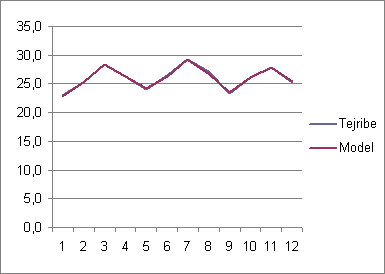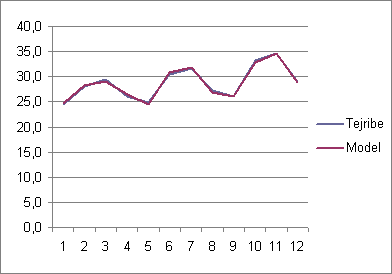Problem urgency
- At present there is an urgent task before the agricultural science - to work out resource-saving, energy efficient, ecologically safe and economically feasible technologies of cultivating crops. Thereupon there is a more and more active development of technologies of “coordinate grid agriculture” (CGA) or, in a more comprehensive sense, the so-called precision agriculture (PA) [1].
- The systemic analysis of problems connected with the application of instant forms of nitric fertilizers has shown the necessity of studying their new forms, the transformation and migration of nitrogen, its balance in soil and in the other components of a landscape. The specifics of the transformation of nitrogen coming from fertilizers as well as particular technologies of their application determine a relatively low (not exceeding 41%) utilization ratio of nitrogen by the first crop [2]. These facts show the necessity of improving the technology of mineral fertilizers usage by introducing very promising slow-acting nitric fertilizers with prolonged action dissolving at set speed, organizing their manufacture and application. A whole complex of economic issues can be resolved through the application of slow-acting fertilizers; it includes an increase in the productivity of plants; the improvement of quality structure of a crop harvest; saving fertilizers and fuel (through reducing the number of fertilizer applications, or dressings); a decrease or absolute avoiding of nitrogen losses on fertilized sites.
- Because of the above-stated facts and propositions, optimizing the conditions of mineral nutrition of cotton through the system of precision agriculture is quite a pressing issue and a necessity for each zone of cotton planting.
- The research objective is to find an adequate method of regulating the ecological balance of agrocenosis through the application of slow-acting mineral fertilizers with prolonged action, using a non-traditional technology of applying fertilizers to layers of soil.
- This present work contains the results of research projects studying the impact of different systems of mineral fertilizing on the cotton crop yield in the conditions of the southern part of Turkmenistan. On the basis of his long-term research the author developed a model system of mineral nutrition in the form of prolonged action fertilizers (research dated 1985-1995 and 2010-2011).
- Methodology and conditions of this research
- The research was conducted by applying the methodology of Uzbek Scientific Research Institute of Cotton Growing on light grey-brownish soils of foothill plain of Kopet Dagh and on meadow soils of the Murghab oasis (Turkmenistan) [3].
- Experiment schemes
- (times and doses of applying the annual norms of fertilizers)
Experiment 1
|
System of mineral nutrition of cotton
|
Yearly norms of nutritional elements in kg/ha of reactant
|
Times and doses of fertilizer application | |||
|
at main plowing |
at pre-sowing cultivation |
at budding |
at flowering | ||
|
Traditional system (application (in portions) of instant forms of mineral fertilizers) |
N125P75K30 N175P125K55 N225P160K70 N275P195K85 |
P45K30 P60K35 P70K40 P90K45
|
N60P30 N70P35 N100P40 N120P45 |
N65 N50K20 N60K30 N75K40 |
- N55P30 N65P50 N80P60 |
Experiment 2
|
System of mineral nutrition of cotton
|
Yearly norms of nutritional elements in kg/ha of reactant |
Times and doses of fertilizer application | |||
|
at main plowing |
at pre-sowing cultivation
|
at budding |
at flowering | ||
|
System with prolonged-action fertilizers (layer-specific localized application of prolonged-action mineral fertilizers)
|
N125P75K30 N175P125K55 N225P160K70 N275P195K85 |
P45K30 P90K35 P120K40 P150K45 |
N125P30 N175P35 N175P40 N200P45 |
- K20 N50K30 N75K40
|
- - - - |
Results of research and their discussion
- The volume of sample selection belongs to the category of very small sample selections (from 5 to 12 samples). We assume that the data is authentic, and we desire to obtain the best approximational model. The main objective is to obtain the best possible model describing the experimental data in the most precise way. At the same time, there is a significant difference between averages obtained by using these technologies, which makes it necessary to analyze this data separately on each technology.
- At a general attempt that we made of analyzing NPK on each technology of application of fertilizers by regular methods, the information value of results has also proved small. Classical regression analysis cannot process this data as the observation matrix is close to singularity. As the classical analysis has proved itself useless, neural networks and genetic algorithms (GA) have been applied. Genetic algorithms represent a new school in algorithmics. They are capable not only of solving and reducing the exhaustive search in complex tasks, but also of easily adapting to a modification of the problem [4].
- GA-function first generates a certain quantity of possible solutions, and then calculates the “survival rate level” for each one, that is, its adequacy, its proximity to the actual facts. In the course of processing data, these solutions produce their “posterity”. Those that “are stronger”, that fit in better, have a greater chance of reproduction, and “the weak” gradually die out. This is a process of evolution. The process repeats itself until the solution is found, or a sufficiently adequate approximation to it [5] is obtained.
- The short summary of the research results is given below.
Model indicators:
Experiment 1.
Adequacy 946,03 of max. 1000.
R-Square: 0,99675.
Correlation coefficient: 0,99837.
Mean square error: 0,0113.
Relative absolute error: 0,0542.
Experiment 2.
Adequacy 921,23 from max. 1000.
R-Square: 0,99269.
Correlation coefficient: 0,99634.
Mean square error: 0,07155.
Relative absolute error: 0,0901.
|
Experiment 1 |
Model |
|
|
|
|
|
|
|
| ||||||||||
|
Crop yield, centners per hectare 23,0 |
22.9 |
|
|
|
|
|
|
|
|
| |||||||||
|
25.2 |
25,2 |
|
|
|
|
|
|
|
|
| |||||||||
|
28,4 |
28,3 |
|
|
|
|
|
|
|
|
| |||||||||
|
26,3 |
26,4 |
|
|
|
|
|
|
|
|
| |||||||||
|
24,1 |
24,2 |
|
|
|
|
|
|
|
|
| |||||||||
|
26,4 |
26,4 |
|
|
|
|
|
|
|
|
| |||||||||
|
29,2 |
29,3 |
|
|
|
|
|
|
|
|
| |||||||||
|
27,1 |
26,9 |
|
|
|
|
|
|
|
|
| |||||||||
|
23,4 |
23,4 |
|
|
|
|
|
|
|
|
| |||||||||
|
26,1 |
26,1 |
|
|
|
|
|
|
|
|
| |||||||||
|
27,9 |
27,8 |
|
|
|
|
|
|
|
|
| |||||||||
|
25,2 |
25,4 |
|
|
|
|
|
|
|
|
| |||||||||
|
Existing nutrition system |
|
|
|
|
|
|
|
|
|
| |||||||||
|
|
|
|
|
|
|
|
|
|
|
| |||||||||
|
Experiment 2 |
Model |
|
|
|
|
|
|
|
|
| |||||||||
|
24,5 |
24,7 |
|
|
|
|
|
|
|
|
| |||||||||
|
28,1 |
28,2 |
|
|
|
|
|
|
|
|
| |||||||||
|
29,5 |
29,1 |
|
|
|
|
|
|
|
|
| |||||||||
|
26,0 |
26,4 |
|
|
|
|
|
|
|
|
| |||||||||
|
24,8 |
24,5 |
|
|
|
|
|
|
|
|
| |||||||||
|
30,5 |
|
30,8 |
|
|
|
|
|
|
|
| |||||||||
|
31,6 |
|
31,9 |
|
|
|
|
|
|
|
|
| ||||||||
|
27,2 |
|
27,0 |
|
|
|
|
|
|
|
|
| ||||||||
|
26,0 |
|
26,1 |
|
|
|
|
|
|
|
|
| ||||||||
|
33,2 |
|
32,8 |
|
|
|
|
|
|
|
|
| ||||||||
|
34,6 |
|
34,6 |
|
|
|
|
|
|
|
|
| ||||||||
|
29,0 |
|
28,9 |
|
|
|
|
|
|
|
|
| ||||||||
|
System of nutrition with prolonged-action fertilizers
|
|
|
|
|
|
|
|
|
|
|
| ||||||||
|
|
|
|
|
|
|
|
|
|
| ||||||||||
|
|
|
|
|
|
|
|
|
|
|
|
| ||||||||
|
|
|
|
|
|
|
|
|
|
|
|
| ||||||||
|
|
|
|
|
|
|
|
|
|
|
|
| ||||||||
|
|
|
|
|
|
|
|
|
|
|
|
| ||||||||
4 nutritional levels: N125P75K30, N175P125K55, N225P160K70, N275P195K85, kg/ha.
1, 2, 3, 4 – first year;
5, 6, 7, 8 – second year;
9, 10, 11, 12 – third year.
|
Nutritional elements |
Times of fertilizer application |
|
K1 |
at plowing |
|
K3 |
at budding |
|
N2 |
at pre-sowing cultivation |
|
N3 |
at budding |
|
N4 |
at flowering |
|
P1 |
at plowing |
|
P2 |
at sowing |
|
P4 |
at flowering |
- Following the traditional technology demonstrates more significant dependence on outward accidental factors such as the weather. Casual fluctuations from one year to another are a clear testimony of this.
- Following the prolonged-action fertilizers technology demonstrates a distinct tendency for growth in productivity with each year, and greater endurance of external disturbances than in following the traditional technology is also observed. The potential of productivity growth in the case of implementing the prolonged-action fertilizers technology is considerably higher than with the traditional technology; it results from the method of fertilizer application as well as from its time periods.
- Using the Monte-Carlo method, best possible optimum values for each technology have been determined through the imitation of 100000 cases.
- Optimum values on traditional technology: K1=45, K3=18, N2=60, N3=50, N4=79, P1=84, P4=72, average crop yield 29.28 centners per hectare.
- Optimum values on the prolonged-action fertilizers technology: K1=45, N2=197, N3=18, P1=59, P2=20, average crop yield 50.36 centners per hectare.
- Thus, the system of mineral nutrition of cotton studied by us is ecologically and economically feasible and can also be recommended as one of the measures directed at improving the condition of environment.
-
- Literature:
- Artemyev A.A. et al. Differentsirovannoe primenenie mineralnykh udobreniy v sisteme tochnogo zemledeliya [Differentiated application of mineral fertilizers in the system of precision agriculture]//Glavny Agronom, 2007, #2. P.7-9.
- Korenkov D.A. Agrohimiya azotsoderzhashchikh udobreniy [The agricultural chemistry of nitrogen-bearing fertilizers]. Moscow, Nauka Publishers, 1976. 208 p.
- Metodika polevyh i vegetatsionnykh opytov s hlopchatnikom [The methodology of field experiments and vegetation experiments with cotton plants]. Tashkent, SoyuzNIKhI, 1973.
- Rana, Soraya. Examining the Role of Local Optima and Schema Processing in Genetic Search. 1999.
- Whitley, Darrel. A Genetic Algorithm Tutorial. 1993.



